There are some recipes that you just love more than others: this Saag Halloumi with Kale is definitely one of them. I have considered getting up for a midnight snack, when I have this waiting for me on the counter. It’s a recipe I have quite literally dreamed of – comfort food with tang and spice. This recipe is loosely based on the Indian classic Saag Paneer, which is made with Paneer, a type of Indian cheese that is hard to source in Europe and the US.
Why you’ll love this Recipe
It’s quick enough for a midweek meal. This Saag Halloumi with Kale doesn’t require much preparation and can be put together in 40 minutes. Less, if you’re an experienced cook.
The ingredients are readily available and don’t require a trip to a speciality Asian grocer. This recipe can be easily made with ingredients available in large grocery stores in Europe and the USA.
It’s nutritionally valuable. While it’s definitely comfort food, it’s a way to consume large quantities of kale: a known superfood. If you’re watching your intake of fat or want to make this recipe plant based, it’s easy to substitute the halloumi with firm tofu.
It’s a great gateway dish for those not used to spices. If you have friends who are sensitive to spices and hot food, use this as a gentle introduction. This recipe does not depend on chilli for it’s taste and is a welcome introduction for those who want to try Indian food but aren’t capable of handling chilli.
Tips for making Saag Halloumi with Kale
Make it plant based. Substitute the Halloumi for firm tofu. Because the halloumi in itself has a little bit of acid, you might need to add more lemon juice to balance out the taste of the kale. If you make this recipe plant based, make sure not to skimp on the spices, they do the heavy lifting in terms of taste.
Make it freezer or pantry based. If you’re low on fresh produce, this recipe still works well. In fact, it’s much cheaper to make, if you’re using frozen produce. Use frozen kale, or alternatively spinach and leave out the tomatoes. The original Indian dish, Saag Paneer, which this dish is loosely based on, is traditionally made without the cherry tomatoes, so don’t sweat it. You can also substitute out the fresh lemon for some lemon concentrate. I always keep some lemon concentrate on hand, in case I forgot to pick up lemons.
Lessons and Trouble Shooting
If you’re using dairy, it has to be halloumi or manouri. I’ve tried making this recipe with mozarella, because it’s more widely available. Mozarella does not works because it melts when added to the hot curry and also reacts with the acid of the lemon juice. I believe other harder cheeses like gouda would also melt. If you find a good alternative to halloumi, let me know in the comments!
If it doesn’t taste quite right, add more acid. This recipe works so well because it balances the more hearty taste of the kale with acid. There are three things in this recipe that naturally add acidity: lemon, tomatoes and the halloumi. If this recipe tastes bland, it’s probably because you need to add more acid. Fresh produce varies in quality. Sometimes the lemons that are available lack acidity and zing, or maybe it’s the tomatoes. This is why I sometimes help balance this dish out by adding concentrated lemon juice. Be sure to add little by little to taste.
Blend garlic, onion and ginger instead of mincing them by hand. This is a hack that I learned in a cooking class in Jaipur, Rajastan in North India. Onion, garlic and ginger form the base of a lot of Indian curries. This is why blending this combination of aromatics with a little water and letting it simmer with a tiny bit of oil is less cutting by hand and allows you to avoid large pieces of ginger or garlic, which some people dislike eating. Letting this mixture simmer takes a bit more time than frying up the aromatics but is well worth it. If you’re planning ahead you can prepare this mixture in advance and use as a very quick prepared base for a lot of curries. This is the method that a lot of Indian restaurants rely on when preparing dishes on demand.
Swaps and Alternatives
Use tofu instead of halloumi. Make sure to use firm tofu so that it doesn’t fall apart, when you combine the tofu with the kale and tomatoes. A firm tofu also allows you to fry it so that it can brown in the pan. This is really important for the flavor. You could also try frying up seitan or another plant based protein source. As mentioned earlier, make sure you have lemons or lemon concentrate and the spices on hand, to add flavor, if you leave out the halloumi.
Use manouri instead of halloumi. If you can’t access halloumi at your local store, manouri works well as an alternative because it fries well. Be aware that manouri lacks the characteristic rubbery and squeaky texture of halloumi. If you’re craving a more traditional taste, manouri is closer to paneer than halloumi. It’s also a little saltier and falls apart easier. Be careful while handling the manouri and watch the salt.
Use frozen spinach instead of kale. As mentioned, the original Indian dish, Saag Paneer, is made with spinach. Spinach has a milder taste and might require you to add less lemon. I love this version too.
Use a generic curry powder mix, if you don’t have the different spices on hand. If you’re just starting out in using spices in your kitchen, don’t worry – you can make this recipe with a mild curry powder. This will usually contain a blend of the spices needed for this recipe. Once you become more comfortable using spices, it’s much cheaper to buy the spice powders in bulk and mix them yourself.
Use a stand mixer to save time
Use a stand mixer or blender: If you have a stand mixer, this will also save you the chopping and mincing of onions, ginger and garlic. This is exactly the kind of time saving that I’m looking for when I’m cooking a weeknight dinner. If you don’t have a stand mixer, mince the aromatics by hand. This works, it’s just more labor intensive.
If you don’t have a stand mixer or blender: Mince the onions, garlic and ginger. Sauté the onions slowly for 10 to 15 minutes until soft and translucent, then add the curry powder, cumin, turmeric, ginger and garlic. Cook for a few more minutes until you can smell the spices, and they’ve incorporated well into the mixture. Make sure not to overfry the spices, this process takes maybe a minute or so max.
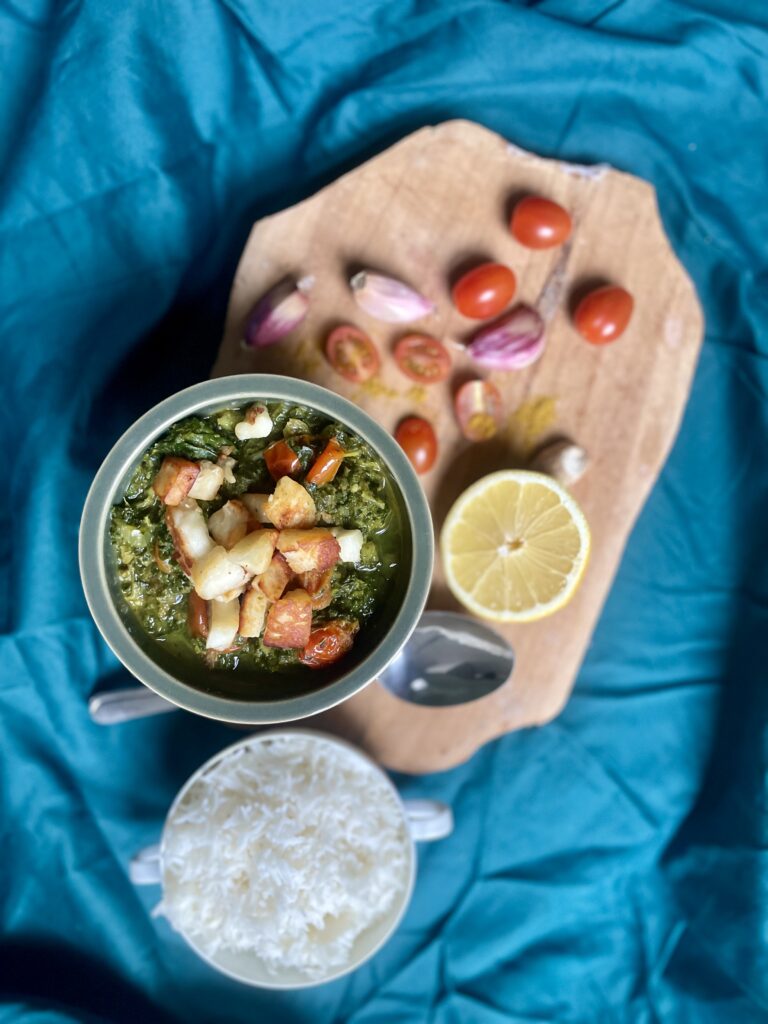
Ingredients for making Saag Halloumi with Kale
- 3 tbsp sunflower oil
- 1 halloumi diced
- 1 cup or 200g cherry tomatoes (optional)
- 1 lemon, or lemon concentrate
- 2,5 cups or 250g frozen kale
Aromatics
- 1 large onions
- 3 cloves of garlic
- 1 knob of ginger, the size of your thumb
Spices
- 1 tsp ground cumin
- 1 tsp ground turmeric
- 1 tbsp curry powder or paprika powder (yes, that much!)
- 1 tsp garam masala
How to make Saag Halloumi with Kale
First, fry the halloumi in a hot skillet or non-stick pan with the oil until golden brown. Remove and set to one side.
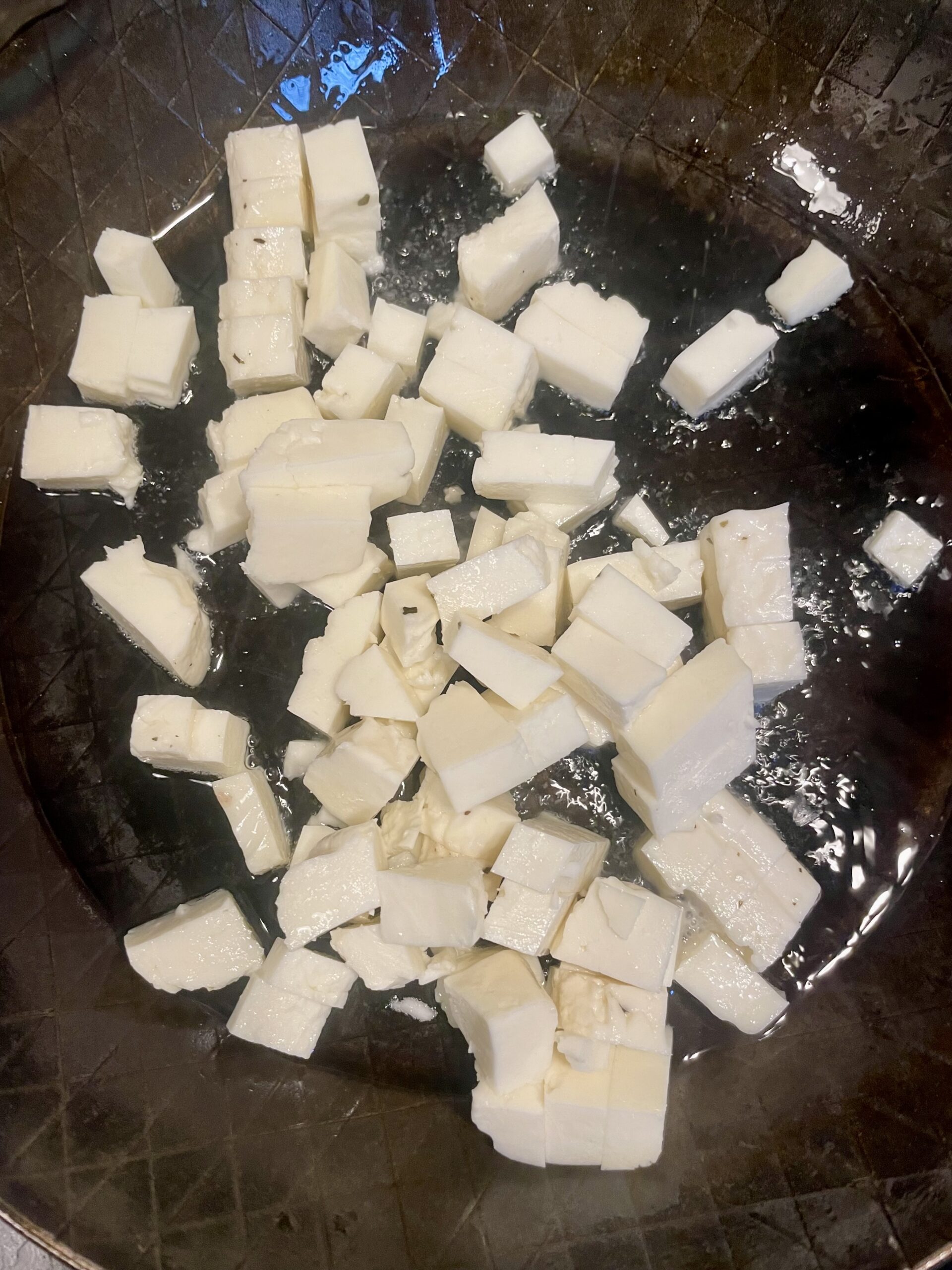
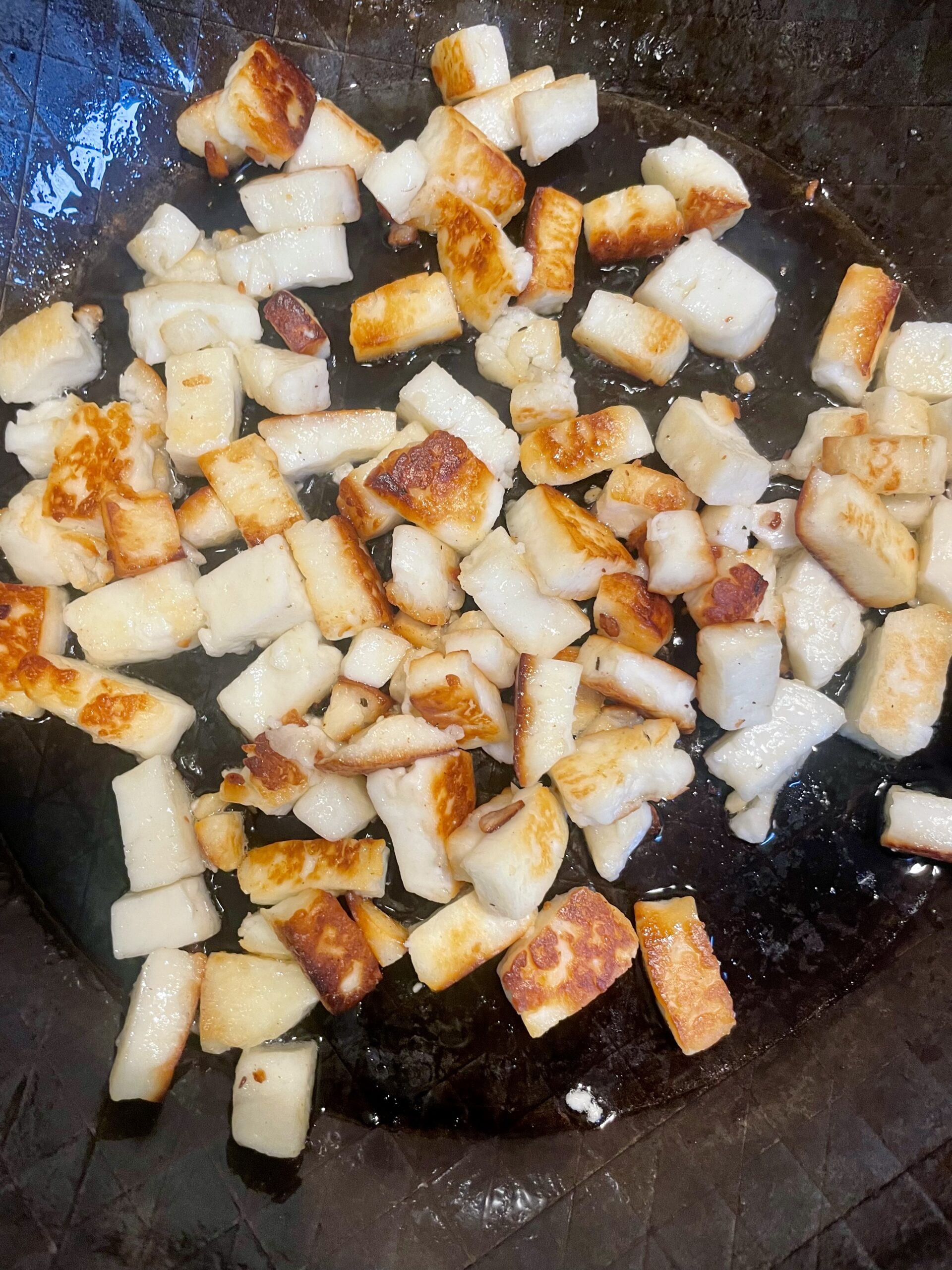
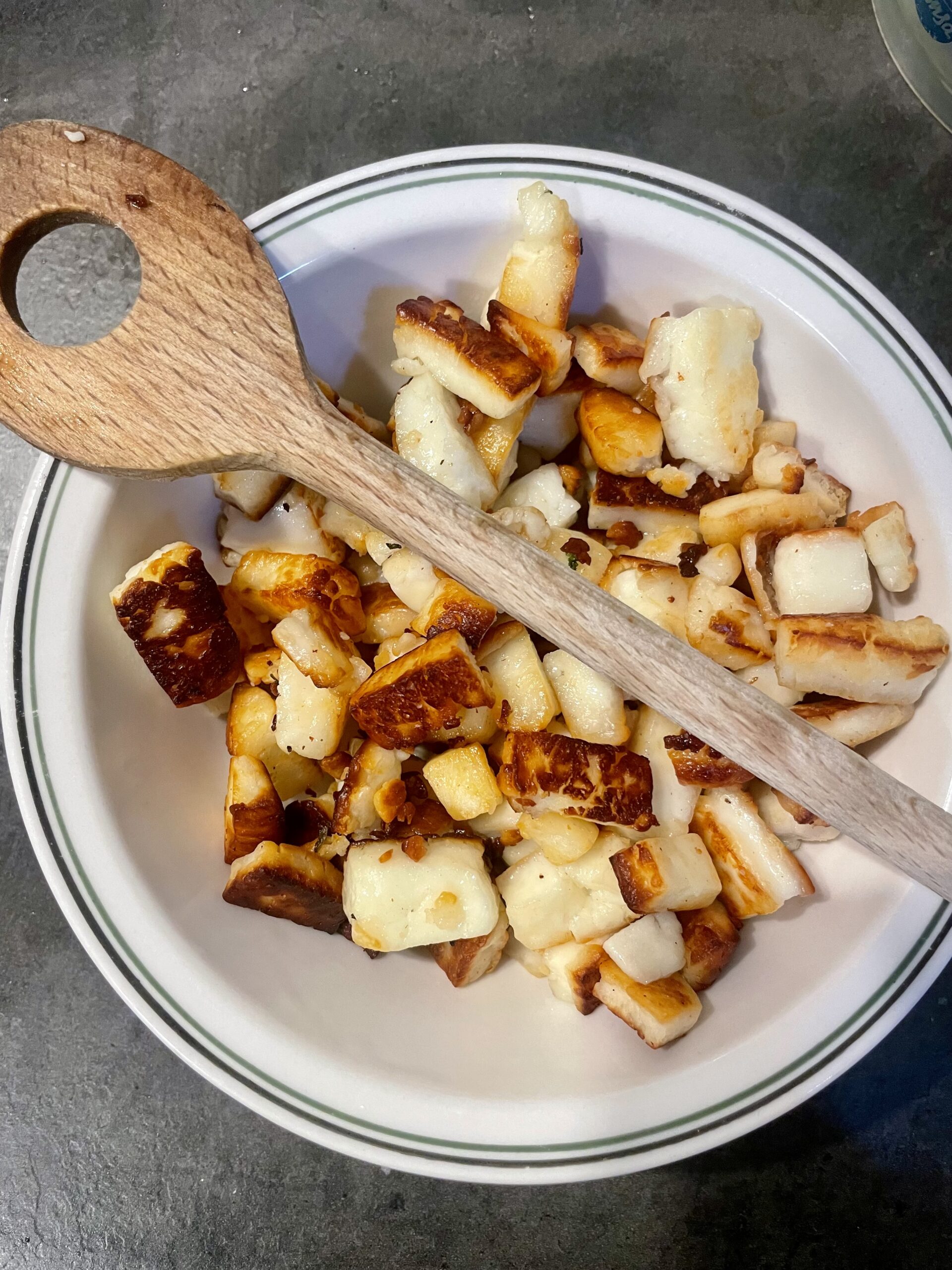
Meanwhile, prepare the frozen kale by adding it to a bowl and pouring it with boiling water. The kale and water will turn bright green. This allows the kale to defrost without cooking. You can set this aside while you follow the next steps.
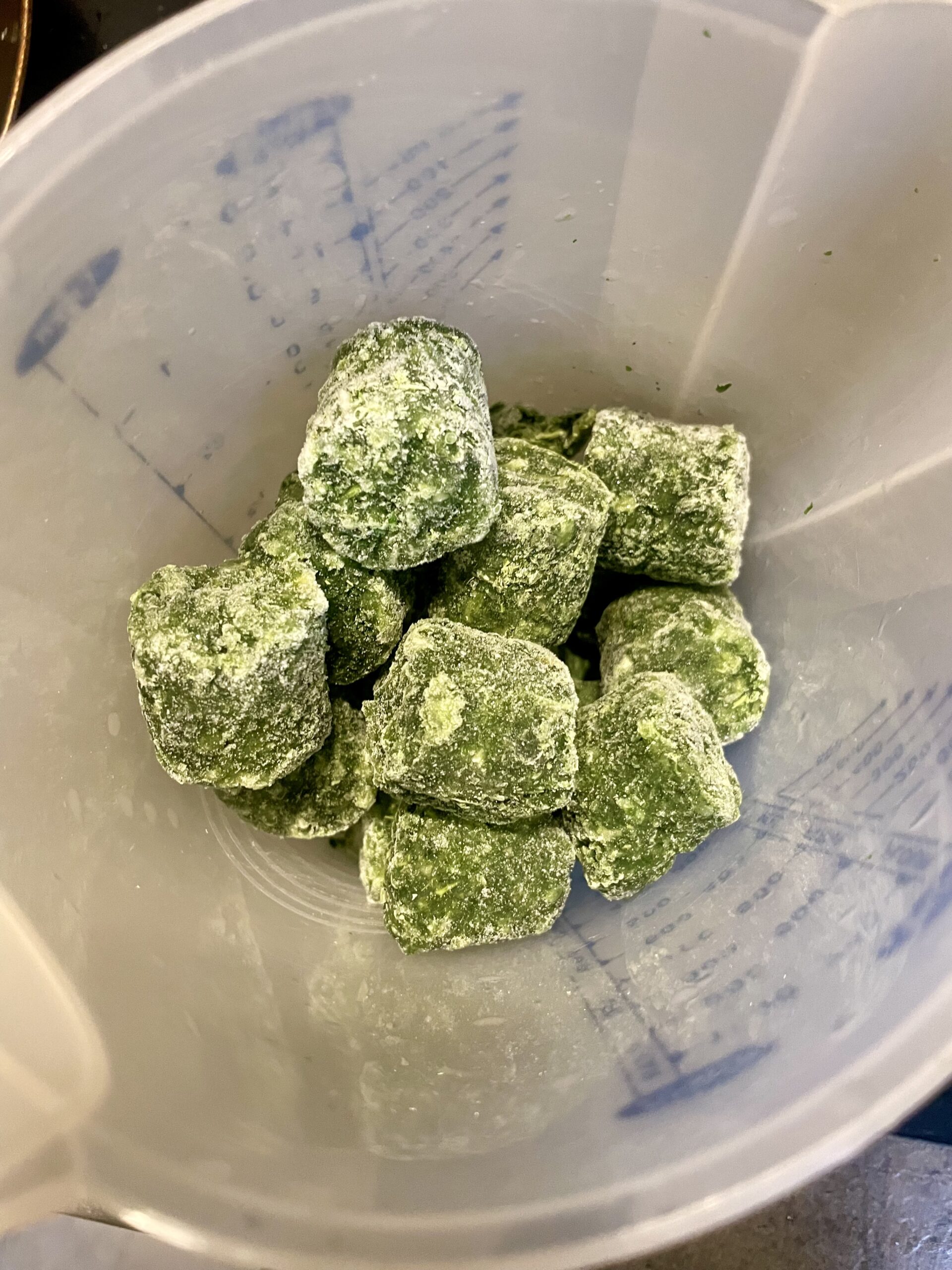
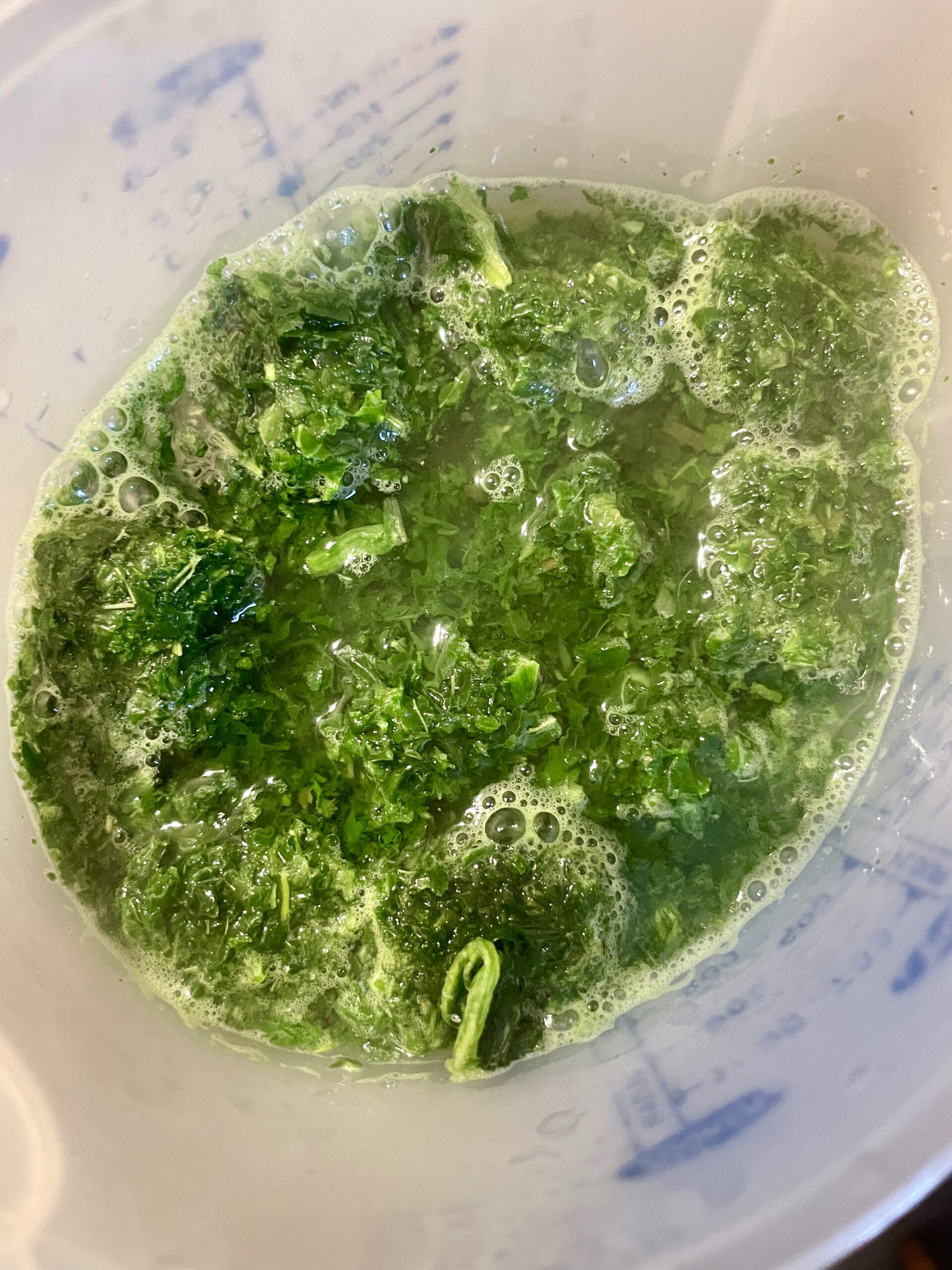
Add the aromatics to the Blender: onion, garlic and ginger to the blender. Add just enough water to make sure the blender can blend this mixture. Blend on a high setting, so you have a soupy mixture. Add this mixture to your smaller skillet with a teaspoon of oil. Set on low to medium heat and let blubber away. Keep an eye on this and turn this down if it begins to boil, it should simmer and reduce a little but retain it’s soupy texture.Using the blender means less cutting and mincing by hand but takes slightly longer for the onion to cook like this, than when it’s fried up and cut by hand.
Once you’ve blended the aromatics prepare the large skillet that you will be using. Add one to two tablespoons of oil to the large skillet. Add enough, so the bottom of the skillet is coated in oil. Warm this oil up on a medium heat. In a separate bowl on the side, mix all the spices together: cumin, tumeric, garam masala and curry powder. Once the oil is warm, add the spices to the oil and use a ladle to blend them. They’ll immediately begin to blubber or “bloom.” The oil will very quickly turn brown and smell intensely. Once you smell this, immediately remove the skillet from the heat. You’re essentially frying the spices and don’t want them to burn. This whole process takes about 30 seconds. Set the skillet aside and don’t keep on the heat.
Now add the cherry tomatoes and cook for a few more minutes until the tomatoes have turned soft.
Next, strain the kale that you’ve let defrost in the water. Add this kale to the large skillet with the fried spices, cherry tomatoes (and minced onions, if you haven’t used a blender). Make sure everything is combined and break down any still frosted pieces of kale with a wooden spoon or ladle.
Now add the soupy mixture of onions, garlic and ginger to the large skillet. This mixture should have reduced a little and turned aromatic.
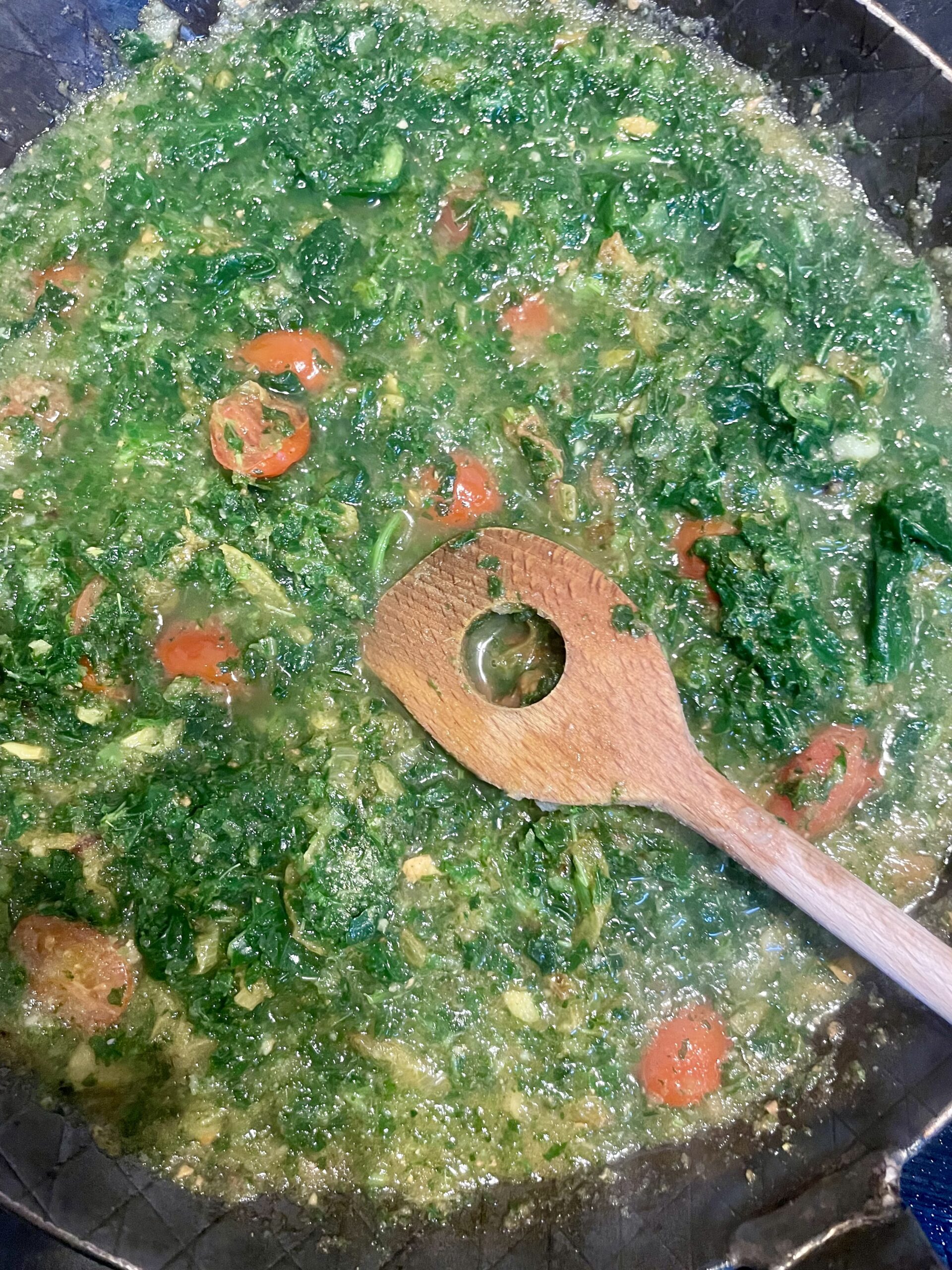
Combine well and add a pinch of salt. I like to keep the salt to a minimum because the halloumi adds a lot of saltiness. Take the large skillet off of the heat now.
Juice half a lemon and add the lemon juice bit by bit, adjusting for taste. If the lemon is not very acidic, juice the other half of the lemon and add it too. Make sure not to heat the mixture up again once you’ve added the lemon, this will take the zing out of the lemon.
Finally, add the halloumi back into the pan and stir together. Serve immediately with rice or naan, chapati or roti.
How to store Saag Halloumi with Kale
I’ve left this overnight on the counter in the winter and fall. Reheat gently and serve with fresh rice the next day. It tastes best, when it’s freshly cooked and the lemon juice is still fresh. If you reheat it, the lemon juice changes and becomes less acidic. It’s usually just as sumptuous, just less tangy if you reheat it the next day. If you’re living in a warmer climate, store in an airtight container in the fridge.
How to pair Saag Halloumi with Kale
This one is a crowd pleaser – I love making this for potlucks or when we have visitors. It pairs well with other Indian dishes and is a great recipe for people who do not tolerate spicy food. Pair with fresh Basmati rice and dhaal (lentils) for a classic spread. Add a yoghurt curry and some poppadoms to add texture and some variation of taste.
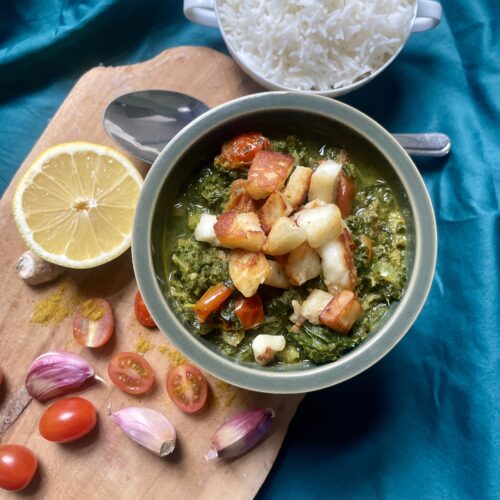
Saag Halloumi with Kale (Saag Paneer)
Equipment
- 1 large skillet or non stick frying pan
- 1 Blender optional, you can also mince the aromatics by hand
- 1 small skillet optional, only necessary if you're using the blender
Ingredients
- 3 tbsp sunflower oil
- 1 halloumi diced
- 1 cup or 200g cherry tomatoes
- 1 lemon
- 2,5 cups or 250g frozen kale
Spices
- 1 tsp ground cumin
- 1 tsp ground turmeric
- 1 tbsp curry powder or paprika powder
- 1 tsp garam masala
Aromatics
- 1 large onions
- 3 cloves of garlic
- 1 knob of ginger the size of your thumb
Instructions
- First, fry the halloumi in a large skillet or non-stick pan with the oil until golden brown. Remove and set to one side.
- Meanwhile, prepare the frozen kale by adding it to a bowl and pouring it with boiling water. The kale and water will turn bright green. This allows the kale to defrost without cooking. You can set this aside while you follow the next steps.
- Blend or Blitz the aromatics: onion, garlic and ginger to the blender. Add just enough water to make sure the blender can blend this mixture. Blend on a high setting, so you have a soupy mixture. Add this mixture to your smaller skillet with a teaspoon of oil. Set on low to medium heat and let blubber away. Keep an eye on this and turn this down if it begins to boil, it should simmer and reduce a little but retain its soupy texture. Using the blender means less cutting and mincing by hand but takes slightly longer for the onion to cook like this, than when it's fried up and cut by hand.
- Now add one to two tablespoons of oil to the large skillet. Add enough, so the bottom of the skillet is coated in oil. Warm this oil up on a medium heat. In a separate bowl on the side, mix all the spices together: cumin, tumeric, garam masala and curry powder. Once the oil is warm, add the spices to the oil and use a ladle to blend them. They'll immediately begin to blubber or "bloom." The oil will very quickly turn brown and smell intensely. Once you smell this, immediately remove the skillet from the heat. You're essentially frying the spices and don't want them to burn. This whole process takes about 30 seconds. Set the skillet aside and don't keep on the heat.
- Now add the cherry tomatoes to the large skillet, in which you fried the halloumi and cook for a few more minutes until the tomatoes have turned soft.
- Next, strain the kale, that you've let defrost in the water. Add this kale to the large skillet with the fried spices, cherry tomatoes (and minced onions, if you haven't used a blender). Make sure everything is combined and break down any still frosted pieces of kale with a wooden spoon or ladle.
- Now add the soupy mixture of onions, garlic and ginger to the large skillet. This mixture should have reduced a little and turned aromatic.
- Combine well and add a pinch of salt. I like to keep the salt to a minimum because the halloumi adds a lot of saltiness. Take the large skillet off of the heat now.
- Juice half a lemon and add the lemon juice bit by bit, adjusting for taste. If the lemon is not very acidic, juice the other half of the lemon and add it too. Make sure not to heat the mixture up again once you've added the lemon, this will take the zing out of the lemon.
- Finally, add the halloumi back into the pan and stir together. Serve immediately with rice or naan, chapati or roti.
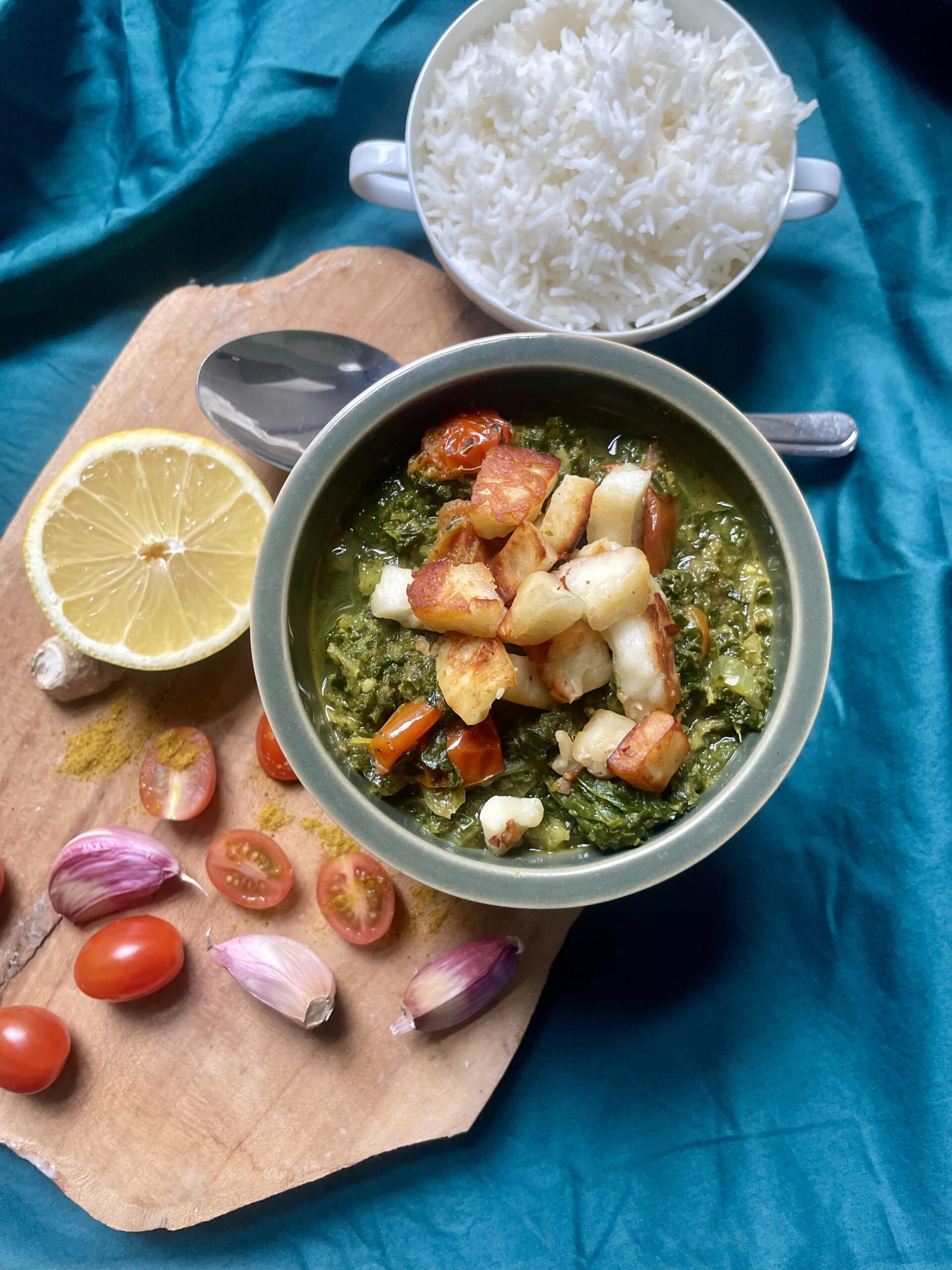
One thought on “Saag Halloumi with Kale (Saag Paneer)”